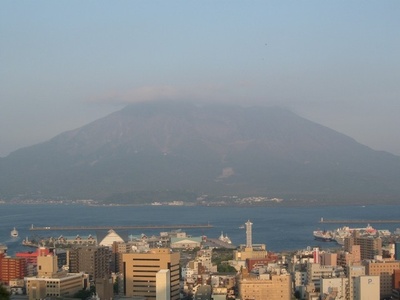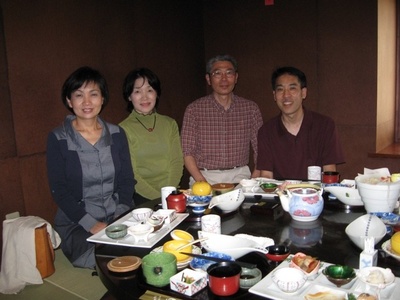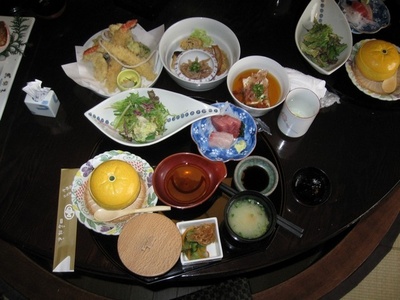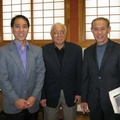Mesmerized by Sakurajima, a majestic symmetrical-shaped volcano whose seductive plume obscures the top of this mountain crater, I wonder what mysteries may lie hidden beneath. Could one of the many stories revealed under the plume’s shadow contain my mother’s family ancestors?
Researching for part of my family’s roots involved a bit of detective work, a lot of patience and a quick prayer or two to find long “lost” relatives in Japan’s Satsuma region. My story has many beginnings. I’m reminded of what the English novelist John Galsworthy once said, “The beginnings … of all human undertakings are untidy.” First, the beginnings of my maternal grandparents’ who hail from Kokubu, Kagoshima-ken, Japan, and their immigration to California’s Salinas Valley in the early 20th century. This is where they partially raised a family of six-children (four in the U.S. and two were raised by an auntie in Kokubu). The second beginning occurred while I was growing up, with the many stories that my grandma Sakoda narrated, usually taking place when she was either cooking food or knitting. She described her village, Shikine, a neighborhood in Kokubu. She recounted how the volcanic ash would fall from nearby Sakurajima and how the parasol she held in her hand was used not only for sun protection, but also for the ash fallout. Everyone had to sweep up after the ash that coats the lush landscape. I once asked grandma Sakoda, “Why did you live next to a volcano?” “Why didn’t you just move?” Remember these naïve questions came from a child - though were they really naïve questions? I didn’t recall an answer.
Another “beginning” was after my Mom passed away and I asked her younger brother, Uncle Sam for any Sakoda family history. He quickly replied and sent a letter with the names of four of my great-grand parents. He wrote down that grandma Sakoda parents’ names were “father – Zenzuke Yanakita and mother – Tsurukane Muroya.” I just assumed this information was correct. Later, I would discover this was not the case. In January of 2009, I finally visited the Japanese American National Museum in Los Angeles. Within the museum the Hirasaki National Resource Center is housed, and I specifically looked for the ship’s passenger lists in which all of my grandparents should be included – somewhere. With the help of Jane Nakasako, a fellow Monterey Peninsulan, we found three out of the four. Reading my grandma Sakoda’s information, she listed her father’s name as “Zenshiro.” While in Japan, I would need his real name of which later I will explain.
Before heading to Japan, I had tried to contact a “key person” to help me during my visit to Kokubu. Well, at least I thought I had found a key person, my cousin’s cousin’s daughter, Yukiko Tsumagari. I had heard about her several years ago at my auntie Haru’s 80th birthday party. I was informed that she taught English and had studied in Australia at one point. Through her email address I found her surname had changed to her married name, Wakamatsu. I sent email messages to her, however I never heard a response until I contacted her in Japan. Yukiko, I found out no longer made her home in Kokubu, but had moved to Mie-ken, though her parents still lived in Kokubu. Now, I had to concentrate on them. Hisao Tsumagari, Yukiko’s father would become my new key person, but not without a struggle.
My friend - Judy in Osaka asked her husband - Masa to help me phone my relatives - or did he volunteer the offer? I think the later. Masa called Yukiko and I spoke to her amid the din of her screaming children in the background. She said her parents might be able to help. Judy’s daughter - Eiko took over after Masa left for work and she spoke to Junko Tsumagari, Yukiko’s mother. Junko was friendly and agreed to pick me up at Kokubu’s train station on a certain day and time, though she must confer with her husband, Hisao who was not at home at that moment. The same day, Hisao called Masa and asked him, why was I calling and how were we related?? Masa explained that I was Hisao’s cousin’s cousin and I was visiting Japan trying to search for my family’s roots. Hisao needed time to think about everything he just heard. He also agreed to allow Masa to call him again after I had spoken to Judy. Judy called me at the hotel that I was staying at in Kyoto and explained that Hisao was hesitant to meet me, he was reluctant to admit he knew my cousins and his relationship with them, and that he was still unsure of how we were related. During the next phone call Masa made, he would hear of the “condition” set by Hisao of what I needed to fulfill before meeting him. I had to hire a Japanese-to-English interpretor. Knowing I was venturing far a field from Tokyo, I knew hiring a Japanese-to-English interpretor is more rare than a 2,000 Yen note in circulation. My back was against the wall, but I’m noooooh quitter because “Persistence” must be my middle name. For those of you who are curious, I’m not a Japanese speaker though I had studied off-and-on and can understand some colloquial Japanese.
Upon arrival at Kagoshimachuo train station, I immediately spotted the “Tourist Information Center” a.k.a. the T.I.C. and began collecting the usual free handouts: Kagoshima city maps, guides, Sakurajima tours, and I finally asked if they could help me locate an interpretor. I didn’t want to spring this on them from the start. Of course, I was told that I needed to reserve an interpretor a week in advance, foolish me I had not. The city must have had a list of volunteer guides. They racked their brains. They looked at phone books and folders that contained something, anything to help. Then, one of the women called Kagoshima Women’s Junior College where she spoke to Setsuko, an administrator who would ask the students at the end of class if anyone wanted to interpret for me, tomorrow. I waited. Setsuko called back and found a former student, Masako who would agree to meet me and interpret from 10A.M. to 4P.M. I felt over-joyed. I knew, at least, that this hurdle was over. When Masako called at my hotel in Kagoshima, I explained my story of what I wanted to get accomplished in Shikine-Kokubu and whom I had contacted. She said that she would call Tsumagari-san and let me know what would happen next. She too told me, the now - familiar story of Tsumagari-san’s reluctance to meet –however, he agreed! Once he was on-board, he would try to give his all. The next day, he was also going to drive his vehicle and pick up the interpretor at her residence in Kagoshima and then me at my hotel at 10A.M.
The next morning, 10A.M. arrived and sure enough a silver Toyota Sienna pulled up in front of the hotel and out popped three adults, none of whom I had ever met before. Tsumagari-san introduced himself and his wife, Junko and Masako-san introduced herself. We entered my hotel to discuss our day’s plan. Tsumagari-san had already prepared some preliminary work by trying to locate any Sakoda and Yanakita family members. Yanakita was my maternal grand mother’s maiden name. He indicated there were many of each family in Kokubu, so which person to contact? I claimed I had no information regarding the Sakoda family, or only anecdotal stories going on 50-years ago, when my grandfather had last visited his hometown. First, Grandpa Sakoda was a regimental man and in Japan trained in the cavalry. He was extremely disciplined and was a farmer in the Salinas Valley. I barely knew my grandfather. I was too young to ask him questions about his life or who was he before he passed.
One story that was passed down from his last and final trip to Japan and Kokubu involved him selling off a mountain. Apparently, his nephew couldn’t sell the land, without my grandfather’s “hanko” or signature chop so he took the liberty to cut down and sell the trees. When, my grandfather saw his mountain denuded, the infamous Kagoshima temper erupted like Sakurajima. You never want to upset a Satsuma-man. He promptly sold the mountain, thus disposing not only the land, but also the Sakoda family ties.
Returning to hunting down the Yanakita family, Tsumagari-san drove the 45-minute drive from Kagoshima city to Kokubu. As far as I can remember the car conversation consisted of us talking about Kagoshima, the abundancy of fish in the bay, the “buri” that were raised inside the floating pylons easily visible through out the Kinko bay. “Buri” is a mature Yellowtail or hammachi tuna. Tsumagari-san also disclosed that he was a retired Policeman. This definitely explained his untrusting behavior and attitude. According to my Dad all Tokyo cops famously hailed from Kyushu. Tsumagari-san was dispatched to Hiratsuka, Kanagawa-ken only two-cities away from where I lived a long time ago in Fujisawa. Kanagawa-ken is adjacent to Tokyo. Talk about a small world. He used his mobile to call ahead for lunch reservations at a restaurant. The restaurant was popular and we settled into a private room near the back. I ordered the tempura that was stacked over three-other dishes, besides the usual rice, miso soup, tsukemono (pickled Satsuma daikon or takuwan), sashimi, chawan mushi that was laced with yuzu rind and orange juice and more. What I immediately noticed was the change in shoyu. Kagoshima-style shoyu is sweet and thick, unlike the salty and thin shoyu that was more familiar to my palate.
After eating the delicious local cuisine our hunt for my Yanakita relatives took full steam. Tsumagari-san knew of a woman whose family had lived many generations in Shikine. Shikine, I later found out was made of many sub-neighborhoods all using Kokubu as part of their description. In my aunt Nobu’s case she lived in Kokubushitai. The Japanese government a few years ago consolidated many smaller cities and now Kokubu is called Kirishima. Upon my meeting the woman whose family had resided in Shikine for generations, she quickly began to call around her elderly female neighbors to ask if any of them knew of my Yanakita family. These elderly female neighbors began to file their way into this woman’s living room one-by-one and I’m beginning to wonder if any of these women were possibly related to me? There was one woman whose wavy hair reminded me of my mother’s and I kept asking myself if she was possibly a relative? I finally did ask. She shook her head to mean “no.” I then displayed photos of my family and began relating stories that my grandmother told me about her family. This was all very pleasant, but we didn’t get any closer to finding a relative. Finally, Tsumagari-san asked to see a phone book and we look up Yanakita and located a “Yanakita, Zenkichi” who was listed. He phoned and spoke to Nobu-san, wife of the late Yanakita-san. She told us that we could visit.
Masako-san, my interpretor related a story, one of several to come forth. There was a Japanese custom for sons and daughters to use part of the “kanji” Chinese character of their parent’s name to name their children. We strike “gold.” My grandmother’s brother, Kumasuke had two sons, one of whom I had learned about just months before this trip. His name was Toyokichi Yanakita. Kumasuke had named his other son using the first part of the “kanji” “Zen,” Zenkichi after his father, Zenshiro.
After saying our heartfelt “good-byes” to all of the ladies and walking to the van, it hits me like a punch to the face, but without the pain. The second I realize that I was about to meet a living relative, the waves of emotion began to well to the surface. My breathing becomes heavy, and I’m trying to take in this moment. Looking out into the distance, I see a completely green saturated foliage hill, probably the same hill that my grandma saw everyday of her young life. After all of these years and the obstacles that I encountered just getting here. I wished every relative living and dead could join me.
© 2009 Troy Ishikawa








